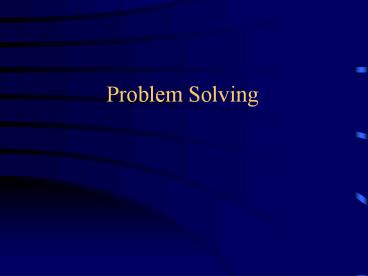Problem%20Solving - PowerPoint PPT Presentation
Title:
Problem%20Solving
Description:
Title: Integrative Studies 410 Our Place in the Universe Author: DRobertson Last modified by: Windows User Created Date: 3/27/2002 9:47:52 PM Document presentation format – PowerPoint PPT presentation
Number of Views:75
Avg rating:3.0/5.0
Title: Problem%20Solving
1
Problem Solving
2
Reminder Quantitative Reasoning
- Amazingly powerful tool to understand the world
around us - Fundamentals
- Ratios
- Graphs
- Area Volume
- Scaling
- Arithmetical statements
3
From Phrase to Equation
- Important skill translate a relation into an
equation, and vice versa - Most people have problems with this arithmetical
reasoning
4
Ratios
- Different types of ratios
- Fractions 45/7 6.42
- Can subtract 7 from 45 six times, rest 3
- With units 10 ft / 100ft
- Could be a (constant) slope, e.g. for every 10ft
in horizontal direction have to go up 1 ft in
vertical direction - Inhomogeneous ratios 2.97/3.8 liters
5
Graphs
- Making a graph
- Create a table with values of the independent
variable and the function - Draw the coordinate system on a piece of paper
- Put in (x,y) pairs
- Connect the dots
- Example y 3x - 1
6
Simple observations profound Questions
- Just using eyes brain can provoke
cosmological questions - Is the Earth the center of the Universe?
- How far away are Sun and Moon?
- How big are they?
- How big is the Earth?
- How heavy is the Earth?
7
Earth or Sun the Center?
- Aristotle (384322 BC)
- Argued that the planets move on spheres around
the Earth (geocentric model) - Argues that the earth is spherical based on the
shape of its shadow on the moon during lunar
eclipses - Aristarchus (310230 BC)
- Attempts to measure relative distance and sizes
of sun and moon - Proposes, nearly 2000 years before Copernicus,
that all planets orbit the Sun, including the
Earth (heliocentric model)
8
Counter Argument or not?
- Objection to Aristarchuss model parallax of
stars is not observed (back then) - Aristarchus argued that this means the stars must
be very far away
9
Measuring the Size of the Earth
- Eratosthenes (ca. 276 BC)
- Measures the radius of the earth to about 20
10
Documentation discerns subtle Effects
- Hipparchus (190 BC)
- His star catalog a standard reference for sixteen
centuries! - Introduces coordinates for the celestial sphere
- Also discovers precession of the equinoxes
11
How far away is the Moon?
- The Greeks used a special configuration of Earth,
Moon and Sun (link) in a lunar eclipse - Can measure EF in units of Moons diameter, then
use geometry and same angular size of Earth and
Moon to determine Earth-Moon distance
12
That means we can size it up!
- We can then take distance (384,000 km) and
angular size (1/2 degree) to get the Moons size - D 0.5/3602p384,000km 3,350 km
13
How far away is the Sun?
- This is much harder to measure!
- The Greeks came up with a lower limit, showing
that the Sun is much further away than the Moon - Consequence it is much bigger than the Moon
- We know from eclipses if the Sun is X times
bigger, it must be X times farther away
14
Simple, ingenious idea hard measurement































